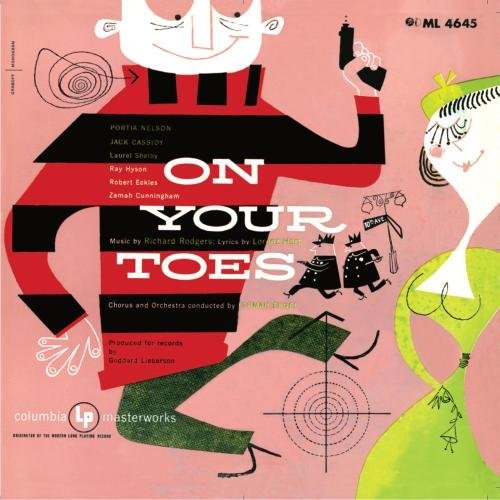There’s a lot going on at Sony’s Masterworks Broadway this spring. First of all, they celebrated the first anniversary of their essential website, with its ever-expanding database of original cast albums. There were contests and festivities galore; each week found the addition of new rare photographs from the productions and recording sessions (600 in the last year alone). The site also has added 65 cast album pages and 50 artist biographies. Seth Rudetsky offers his video “deconstructions” on a regular basis while Peter Filichia’s blog is a Tuesday perennial.
Consistently throughout this past year, Sony has made good on its promise to release many of the albums that haven’t been heard since they were originally released on vinyl. Many of the classics are also being reissued, but it’s the digital debuts that have me the most excited. The three new releases are available as digital downloads from the Masterworks site or disc-on-demand presses from ArkivMusic.
First up is the 1952 studio cast of On Your Toes, the smart, sophisticated Rodgers and Hart tuner opened in 1936, just a few years before the original cast album came into vogue. The show, which made a concerted effort to integrate dance (here ballet) into the storyline and made a star out of lead hoofer Ray Bolger. George Balanchine’s dances, specifically his eleven o’clock ballet “Slaughter on Tenth Avenue” were exceptionally well-received. The 1983 revival has what is the definitive reading of the score, but this studio album makes for pleasant listening with two of musical theater’s most interesting voices of the 1950s, Jack Cassidy and Portia Nelson, undertaking most of the singing. The master himself, Goddard Lieberson, produced the album with Lehman Engel conducting. The famed “Slaughter” ballet was recorded, almost in its entirety. This studio album has more pop than the 1954 Broadway revival recording (which only takes off when Elaine Stritch sings, which included an interpolated showstopper “You Took Advantage of Me”).
Richard Rodgers presented the marvelous “Music Theater of Lincoln Center” series throughout the 1960s. At the State Theater, there would be limited run summer revivals of popular musicals, many of which featured original stars. Most of these special revivals were recorded by Columbia and RCA. Now Masterworks Broadway has released the only one that has been unavailable, The Merry Widow. The famed Franz Lehar operetta was a smash summer hit, directed by Edward Greenberg and conducted by Franz Allers. The resulting cast album is blissfully elegant, a vibrant, exceptionally well-sung recording. This was actually my first experience hearing The Merry Widow (outside Shadow of a Doubt) and my God, is it a magnificent score.
Patrice Munsel, former Met diva turned musical comedy star, sings a sumptuous Sonia (they used the Chappell edition), particularly on the famed “Vilja.” Munsel was the youngest star of the Metropolitan Opera and later transitioned into musical comedy (her roles ran the gamut: Maria in The Sound of Music to Margo Channing in Applause). Her singing is perfection and full of vibrancy. She’s given magnificent support from baritone Bob Wright. The woefully under-recorded Joan Weldon (who is simply ravishing on the original cast recording of Kean) and Frank Poretta provide thrillingly sung support. Rounding out the cast are the always reliable character actors Mischa Auer and Sig Arno
Speaking of Ms. Munsel, on June 14 Sony will be releasing another rarity: the 1955 RCA-Victor studio cast recording of Carousel. I’m of the opinion that every recording of this Rodgers and Hammerstein classic is worth owning, and this is no exception. It marked the first time “Geraniums in the Winder” was recorded and flows less like a studio album and more like an album from a stage production. This disc was recorded for RCA under the baton of Lehman Engel. A couple of tracks were heard on the reissue of the Music of Lincoln Center Carousel, but this marks the complete digital debut for this wonderful recording (Meanwhile I wonder who we have to see about another essential studio recording: the 1962 Command Records reading of the score with Alfred Drake, Roberta Peters and Lee Venora).
Robert Merrill makes a grand Billy Bigelow, singing with that rich, soaring operatic baritone. Munsel is heaven as Julie, though she hasn’t as much to sing here. George S. Irving brings a great deal of character to Jigger, with limited time on disc (his “What?!” in “Geraniums” is priceless). Herbert Banke soars to tenor heights as Enoch while newcomer Florence Henderson makes an exceptional Carrie. Gloria Lane’s Nettie is well sung, but lacking the magic of Christine Johnston or Claramae Turner.
For cast album aficionados there are the many classics being released digitally as well as the new budget cardboard eco-pack editions of their bestsellers. These reissues are not remastered or upgraded aurally from previous releases, but puts the recordings back into the market. Most notably, Damn Yankees is being reissued with its original green LP cover featuring Gwen Verdon in a baseball uniform (sidebar: I have this rare LP). The show opened to good reviews, but less than ebullient business. However, the powers-that-be changed the marketing strategy by replacing wholesome Gwen with scintillating “Lola” against a fire engine red background. The rest is history. Other titles include Merrily We Roll Along, Into the Woods, The Secret Garden, Anything Goes (1987), Fosse, Sunday in the Park with George, And the World Goes Round and Pacific Overtures. (Unlike all other RCA Sondheim OBCRs, the latter has not been remastered and could use the sprucing up; it’s still Sondheim’s most intriguing score).
The following titles are available for digital download for the first time: Christine, First Impressions, Juno, Oh Captain, Mr. President, The Happiest Girl in the World, To Broadway with Love and Brigadoon (1957 studio cast). On June 28, The Girl in Pink Tights, Runaways, Kean and Maggie Flynn will also be released.
